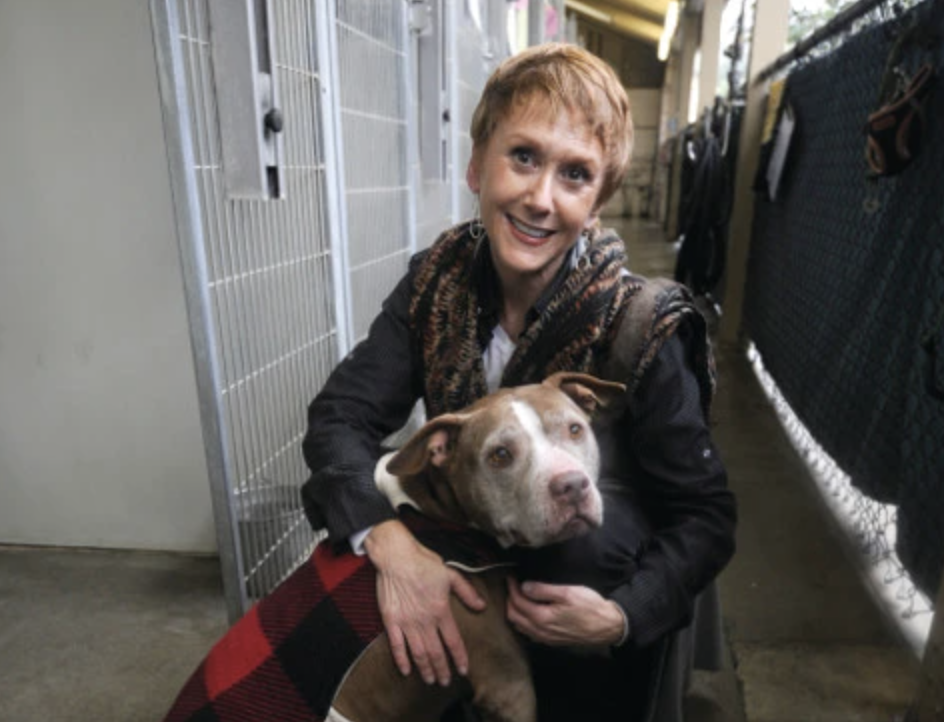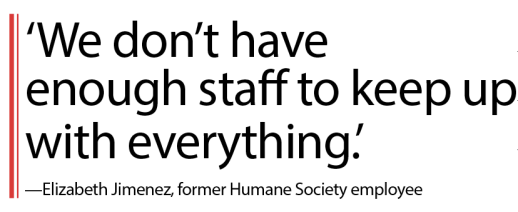In the Doghouse: 13 Employees Quit Santa Barbara Humane Society
Leadership Blamed for Hostile Work Environment

Animal rescue and welfare, even in the best of times, is exceptionally difficult work. Lives hang in the balance, and the industry attracts impassioned people who frequently disagree over the best methods of care and rehabilitation.
Yet among the region’s rescue organizations, Santa Barbara Humane (SBH) stands out as a place where executives and staff have had an especially hard time seeing eye-to-eye. In the last six months, 13 SBH employees — some of whom had worked for the shelter for more than a decade — have quit over what they describe as a hostile work environment created by Chief Operating Officer Dori Villalon.
Over the past several weeks, the Santa Barbara Independent has received numerous complaints from the former employees. In explaining their reasons for leaving, they unanimously cited the management style of Villalon, Chief Executive Officer Kerri Burns, and other leadership members. “I left because my mental health was poor, largely because of the toxic work environment,” said one 10-year employee, who asked to remain anonymous.
Since the Independent began reporting this story, SBH has made some efforts to connect with the staff that remain, sending out a survey on January 17 in order to “create a plan for improvements we think should be made to better the workplace experience,” said Burns.
Marlena Piacenza was the most recent employee to resign. She had worked as SBH’s shelter manager for nearly three years before deciding to leave this week. “Everybody feels silenced,” she said. Piacenza explained the coordinated outcry from former employees was purposeful and the culmination of months of unhappiness and fruitless attempts to address their concerns internally.
The concerns themselves weren’t unusual, Piacenza said — a scheduling problem, questions over a decision to euthanize, friction between bosses and staff. It was how management addressed these issues, the employees said, that compelled them to move on from the organization. “In the two years I worked there, I never got in trouble,” Piacenza said. “It wasn’t until I started raising concerns that my job was threatened.”
Villalon’s general response to the criticism is that animal welfare is an emotional industry and that employees are often not open to operational changes. Villalon joined SBH in 2019 and before that worked for three years as a manager for the Santa Barbara County Animal Services department. “I don’t think someone has a successful 30-year career if they aren’t effective,” she said. Her defenders say she is an effective, if at times blunt, leader, and that the pandemic has put a pronounced strain on the shelter with general burnout factoring into the recent resignations. The remaining staff, they point out, have not expressed the same discontent as the group that left.
Sign up for Indy Today to receive fresh news from Independent.com, in your inbox, every morning.
However, in her previous posts at different animal welfare organizations across the country, Villalon has been the subject of complaints nearly identical to the ones brought forward here in Santa Barbara. Several news articles were published about the pushback she received at the San Francisco SPCA, where she was Vice President from 2008 to 2010, and at Sonoma County Animal Care and Control, which she oversaw from 2006 to 2007. In these articles, employees similarly accused her of creating an unhealthy work environment.
Burns, however, also defended Villalon. “In animal welfare, there’s a lot of emotions,” she said. “There are always tough decisions to be made.” When asked about previous news coverage of Villalon’s career, including an article that detailed a petition with more than 500 signatures to remove her from her position in San Francisco, Burns said, “I’ve known Dori for over 20 years .… anyone can Google anyone.”
Another common accusation among Villalon’s critics is that she is frequently too quick to decide that a troubled dog is beyond rehabilitation and ought to be euthanized. Elizabeth Jimenez, a two-year employee who resigned January 6, decided to leave her position after an argument with Villalon over a dog with a history of biting. “Dori went on about how we should not take in animals with bite history and that an animal with a bite history would be deemed unadoptable,” Jimenez said. “I asked if any animal with any bite history would be euthanized, and she got upset and defensive and accused me of trying to back her into a corner.”
Employees said the lack of collaboration between staff and leadership was most obvious when the shelter would decide how to handle animals with behavioral problems. Piacenza said the meetings often felt pointless. “No matter what you say, if Dori wants euthanization, that’s what’s going to happen,” Piacenza said. She described several situations where behavioral staff would make progress with an aggressive dog, putting hours of work into building trust and helping the dog conquer its fears, only for it to be put down.

Piacenza and another former employee, Janelle Perry, both spoke about being disturbed by the decision to euthanize Elle, a 6-year-old pit bull mix. “She had stranger danger,” Perry said. “But once she built that trust for you, she was your best friend.” Worried that Elle was headed for the needle, employees suggested reaching out to another rescue group that uses more intensive, and sometimes controversial, training methods, including shock collars. SBH wouldn’t allow it and ordered Elle euthanized. “They had other options,” Piacenza said. “But they would rather kill a dog than give it a chance, because of training they don’t agree with.” When asked about this incident, Burns said, “At the time the decisions were made, there were no staff objections.”
Villalon noted that the shelter boasts a 96 percent live release rate as of November 2021, with more than 1,100 animals being adopted, 997 being transferred to a different facility, and more than 15,000 receiving veterinary care in 2021. “We are considered a socially conscious shelter,” she said. “We don’t turn dogs away. That said, we are going to receive dogs with medical or behavioral issues that will not be safe in the community.”
Piacenza said the sudden departure of so many employees has taken the biggest toll on the animals. “Most of them get no time [with behavioral staff] at all,” she said. The exodus has also caused a backlog of laundry, dishes, and cleaning. “No help or support from leadership doesn’t help the situation,” she said.
Jimenez described how only one or two employees are now tasked with taking care of every animal at the shelter, ensuring they are walked several times a day and given time to play outside of their kennel. But there often just isn’t enough time. “We don’t have enough staff to keep up with everything,” she said. “The dogs used to be so much happier, and now they’re so uncomfortable there.”
Editor’s Note, January 28: In a statement, SBH said it wished to clarify that Villalon does not make euthanasia decisions alone. “If an animal is not thriving in the shelter environment, the Outcome Evaluation Team (OET) ensures all viable options are exhausted before a euthanasia decision is made,” the organization said. “The team is comprised of 8-10 employees, including veterinarians, certified dog trainers, and experienced animal care and medical staff who discuss everything they know and have observed about an animal – and whether we think that animal can be a safe member of our community.”
“The assertions that the animals are not happy because these former employees were not happy were grossly misleading and insulting to the incredible efforts of our shelter teams and volunteers,” the statement continued. “We are currently at low capacity with our facilities. Not only is our Live Release Rate one of the highest in the nation, 96% compared to the national average of 89%, our Length of Stay is half of the national average. Our dogs are walked 2-3x a day and have enrichment in between, with large yards to plan in during the day. Cats have large indoor and enclosed outdoor condos. The quality and care of our animals is – and has always been – our utmost priority.
Support the Santa Barbara Independent through a long-term or a single contribution.




You must be logged in to post a comment.